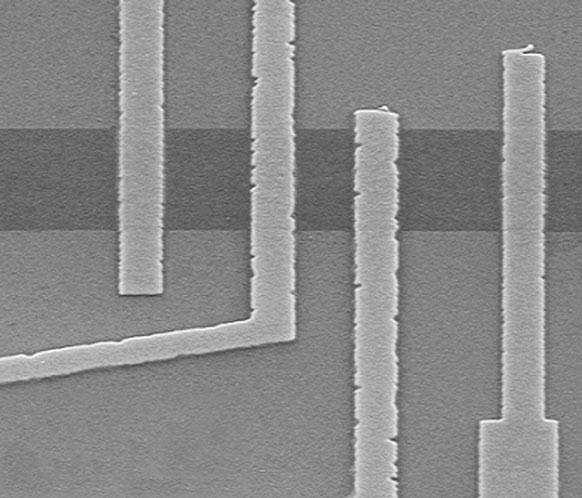Three-Way Transistors
Source: “Triple-mode single-transistor graphene amplifier and its applications”
Kartik Mohanram et al.
ACS Nano 4: 5532-5538

Results: Researchers built a single-stage graphene transistor amplifier and demonstrated that it can perform three functions in one: it can conduct positive charge, negative charge, or both simultaneously. The device can encode a data stream by changing the frequency or the phase of a signal—a task that usually requires multiple transistors in a circuit.
Why it matters: Previous research on graphene has focused largely on how fast it conducts electrical charge; graphene transistors are 10 or more times as fast as silicon ones. The new work demonstrates that they have other advantages as well. Because a single graphene transistor can do the work of multiple silicon transistors, graphene could be integrated into more compact chips for wireless telecommunication devices, such as RFID tags and Bluetooth headsets.
Methods: Researchers at Rice University hypothesized that a graphene transistor with three electrical terminals, the structures that control and conduct current flow, could be operated in such a way that the transistor would switch between states where it conducts positive charge, negative charge, and both. Using standard techniques for making graphene circuits, researchers at the University of California, Riverside, fabricated the circuits, adding metal electrodes and an off-chip resistor to a small piece of single-layer graphene. Tests demonstrated that the resulting single-stage amplifier behaved as predicted, switching states when different voltages were applied. The device could also act as an amplifier in common methods of transmitting data through digital modulation of a reference signal.
Next steps: The researchers are now attempting to integrate multiple graphene transistors into a circuit for more complex applications.
More Power per Photon
Researchers demonstrate a way to convert more of the energy in light into electricity
Source: “Multiple Exciton Collection in a Sensitized Photovoltaic System”
Bruce Parkinson et al.
Science 330: 63-66
Results: Researchers created a solar cell capable of collecting multiple electrons for each high-energy photon absorbed, and they managed to directly measure the electron output.
Why it matters: Although researchers have steadily increased the amount of electricity that solar cells can produce, they face fundamental limits imposed by the physics of converting photons to electrons in semiconductor materials. Conventional solar cells convert only one wavelength of light efficiently; either they fail to absorb other wavelengths of light or they throw away extra energy as heat. The researchers have shown that it’s possible to capture some of this extra energy, by transferring the energy in each high-energy photon to more than one electron. The approach could be used to produce ultraefficient yet inexpensive solar cells.
Methods: Although other researchers had confirmed that a photon’s energy can be transferred to more than one electron, no one had directly measured this phenomenon in a solar cell because the extra electrons are too short-lived. In this case, however, the researchers used semiconducting nanocrystals called quantum dots as the active solar-cell material, modifying their surface chemistry to create a strong bond between them and a semiconducting oxide crystal substrate. The bond allowed the electrons to move quickly from the quantum dots into the semiconductor, where they were measured as current.
Next steps: The active material in the quantum-dot test cells is so thin that almost all light passes through it unabsorbed. The researchers suggest solving this problem by adding a thin layer of it to an extremely porous material with a large surface area. The researchers are also working with different types of quantum dots that have the potential to absorb and convert more light.
Keep Reading
Most Popular
Large language models can do jaw-dropping things. But nobody knows exactly why.
And that's a problem. Figuring it out is one of the biggest scientific puzzles of our time and a crucial step towards controlling more powerful future models.
The problem with plug-in hybrids? Their drivers.
Plug-in hybrids are often sold as a transition to EVs, but new data from Europe shows we’re still underestimating the emissions they produce.
Google DeepMind’s new generative model makes Super Mario–like games from scratch
Genie learns how to control games by watching hours and hours of video. It could help train next-gen robots too.
How scientists traced a mysterious covid case back to six toilets
When wastewater surveillance turns into a hunt for a single infected individual, the ethics get tricky.
Stay connected
Get the latest updates from
MIT Technology Review
Discover special offers, top stories, upcoming events, and more.